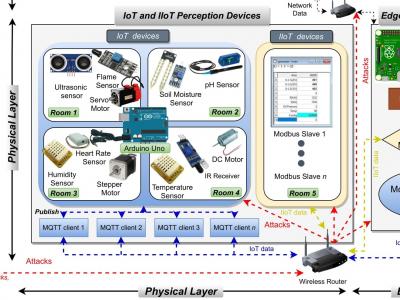Machine Learning

The dataset represents the input data on which the article Bayesian CNN-BiLSTM and Vine-GMCM Based Probabilistic Forecasting of Hour-Ahead Wind Farm Power Outputs, is based. The data consist of a two-year hourly time series of measured wind speed and direction, air density, and production of two wind farms (WTs) in Croatia (Bruška and Jelinak). In addition to the two listed WTs, measurements of two nearby WTs (Glunca and Zelengrad) are also attached in training files (these WPPs are not directly analyzed in the article).
- Categories:
 1477 Views
1477 ViewsIn this project, we propose a new comprehensive realistic cyber security dataset of IoT and IIoT applications, called Edge-IIoTset, which can be used by machine learning-based intrusion detection systems in two different modes, namely, centralized and federated learning. Specifically, the proposed testbed is organized into seven layers, including, Cloud Computing Layer, Network Functions Virtualization Layer, Blockchain Network Layer, Fog Computing Layer, Software-Defined Networking Layer, Edge Computing Layer, and IoT and IIoT Perception Layer.
- Categories:
 23430 Views
23430 ViewsThis dataset has been employed in the following articles:
https://ieeexplore.ieee.org/document/9682692
https://ieeexplore.ieee.org/document/9871051
https://content.iospress.com/articles/technology-and-health-care/thc202198
- Categories:
 467 Views
467 Views
The millimeter-wave radar has the ability to sense the subtle movement of hand. However, the traditional hand gesture recognition methods are not robust in the scenario with dynamic interference. To address this issue, a robust hand gesture recognition method is proposed based on the self-attention time-series neural networks. Firstly, the original radar echo is constructed in terms of frame, sequence and channel at the input terminal of network.
- Categories:
 455 Views
455 ViewsThe measurement and diagnosis of the severity of failures in rotating machines allow the execution of predictive maintenance actions on equipment. These actions make it possible to monitor the operating parameters of the machine and to perform the prediction of failures, thus avoiding production losses, severe damage to the equipment, and safeguarding the integrity of the equipment operators. This paper describes the construction of a dataset composed of vibration signals of a rotating machine.
- Categories:
 2755 Views
2755 Views
Power system state estimation (PSSE) plays a vital role in stable operation of modern smart grids, while it is vulnerable to cyber attacks. False data injection attacks (FDIA), one of the most common cyber attacks, can tamper with measurement data and bypass the bad data detection (BDD) mechanism, leading to incorrect PSSE results.
- Categories:
 1045 Views
1045 Views
One of the industries that uses Machine Learning is Radiation Oncology
- Categories:
 171 Views
171 ViewsFecal microscopic data set is a set of fecal microscopic images, which is used in object detection task. The datasets are collected from the Sixth People’s Hospital of Chengdu (Sichuan Province, China). The samples were went flow diluted, stirred and placed, and imaged with a microscopic imaging system. The clearest 5 images were collected for each view of each sample with Tenengrad definition algorithm. The dataset we collected includes 10670 groups of views with 53350 jpg images. The Resolution of images are 1200×1600. There are 4 categories, RBCs, WBCs, Molds, and Pyocytes.
- Categories:
 726 Views
726 Views




